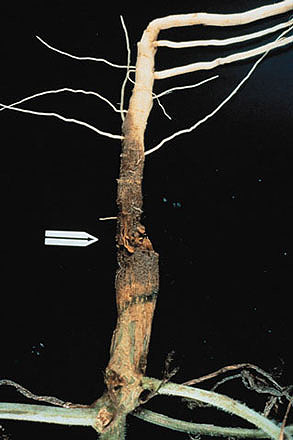Contributed by
R. D. Martyn
Purdue University
Botany & Plant Path. Dept.
West Lafayette, IN 47907-1155
Fusarium crown and foot rot of squash and pumpkin is caused by a forma specialis of Fusarium solani (Mar.) Sacc. The pathogen exhibits host specificity and exists as races, like the formae speciales of F. oxysporum causing vascular wilts of cucurbits. Fusarium crown and foot rot of squash was first described in detail in South Africa in 1932. It has also been reported in Australia, Canada, and the United States; however, its known distribution in the United States is limited. The disease has been described by various names, including wilt, root rot, foot rot, root and stem rot, and cortical rot.
Symptoms

Fig. 1. Fusarium crown and foot rot of watermelon caused by Fusarium solani f. sp. cucurbitae. Courtesy R. D. Martyn. (Click image for larger view). |
|
Usually, the first symptom noticed in the field is wilting of the leaves. Within several days, the entire plant wilts and dies. If the soil is removed from around the base of the plant, a very distinct necrotic rot of the crown and the upper portion of the taproot is evident. The rot develops first as a light-colored, water-soaked area, which becomes progressively darker. It begins in the cortex of the root, causes cortex tissue to slough off, and eventually destroys all of the tissue except the fibrous vascular strands (Fig. 1). Infected plants break off easily about 2–4 cm below the soil line. The fungus is generally limited to the crown area of the plant. The main and lower portion of the taproot are not affected, except under extremely wet conditions. Likewise, the stem is not affected, except for the lower 2–4 cm immediately above the soil line. Plants showing symptoms develop numerous sporodochia and macroconidia, giving the mycelia a white to pink color on the stem near the ground surface. Fruits are attacked at the fruit-soil interface (Fig. 2); the severity of the fruit rot is dependent on soil moisture.
|
 
Fig. 2. Fusarium fruit rot of pumpkin caused by Fusarium solani f. sp. cucurbitae. Courtesy T. A. Zitter. (Click image for larger view).
|
|
Causal Organism
Fusarium crown and foot rot of squash is caused by
F. solani f. sp.
cucurbitae W. C. Snyder & H. N. Hans. Two races have been described. Race 1 causes a root, stem, and fruit rot and occurs worldwide. Race 2 causes only a fruit rot and has been reported only in California and Ohio. Recent work, however, has separated these two races into different mating populations, which most probably represent different species.
F. solani f. sp.
cucurbitae forms all three asexual spore types (microconidia, macroconidia, and chlamydospores) typical of
Fusarium and a sexual stage when proper mating types are introduced; however, perithecia have not been observed in nature. Pathogenic isolates of
F. solani are generally heterothallic (having two or more mating types). The teleomorph is
Nectria haematococca Berk. & Broome (syn.
Hypomyces solani (Rke. & Berth.) W. C. Snyder & H. N. Hans.). Numerous strains of
F. solani f. sp.
cucurbitae have been found, and there is a high degree of variability in the fungus.
Disease Cycle
Both races can be internally or externally seedborne. However,
F. solani f. sp.
cucurbitae apparently survives for only 1–2 years in seed. Infection does not appear to affect seed viability or germination. Although the fungus produces abundant chlamydospores, it apparently survives for only 2–3 years in soil, which is much less than
F. oxysporum or even other formae speciales of
F. solani. Since the perfect stage has not been observed in nature, ascospores probably do not play a significant role in survival. Plants and fruit of any age can be infected. In the field, the disease is generally a problem only in summer squash and certain pumpkin cultivars; however, laboratory studies have shown that most cucurbits are susceptible, including melon and watermelon. Mature cucumber is much less susceptible than other cucurbits, but all are equally susceptible in the seedling stage.
Control
Fusarium crown and foot rot occurs sporadically in most areas, and disease severity is dependent on soil moisture and inoculum density. Because the fungus survives in the soil for only 2–3 years, a 4-year rotation is usually adequate for disease control. Planting fungicide-treated seed is also effective in reducing the incidence of disease initiated from infected seed.
Selected References
Champaco, E. R., Martyn, R. D., and Miller, M. E. 1993. Comparison of Fusarium solani and F. oxysporum as causal agents of fruit rot and root rot of muskmelon. HortScience 28:1174-1177.
Nash, S. M., and Alexander, J. V. 1965. Comparative survival of Fusarium solani f. cucurbitae and F. solani f. phaseoli in soil. Phytopathology 55:963-966.
Paternote, S. J. 1987. Pathogenicity of Fusarium solani f. sp. cucurbitae race 1 to courgette. Neth. J. Plant Pathol. 93:245-252.
Sumner, D. R. 1976. Etiology and control of root rot of summer squash in Georgia. Plant Dis. Rep. 60:923-927.
Tousson, T. A., and Snyder, W. C. 1961. The pathogenicity, distribution, and control of two races of Fusarium (Hypomyces) solani f. cucurbitae. Phytopathology 51:17-22.
Van Etten, H. D., and Kistler, H. C. 1988. Nectria haematococca mating populations I and VI. Pages 180-206 in: Advances in Plant Pathology. Vol. 6. D. S. Ingram and P. H. Williams, eds. Academic Press, New York.
RETURN TO Fusarium Rot
RETURN TO APSnet FEATURE STORY
